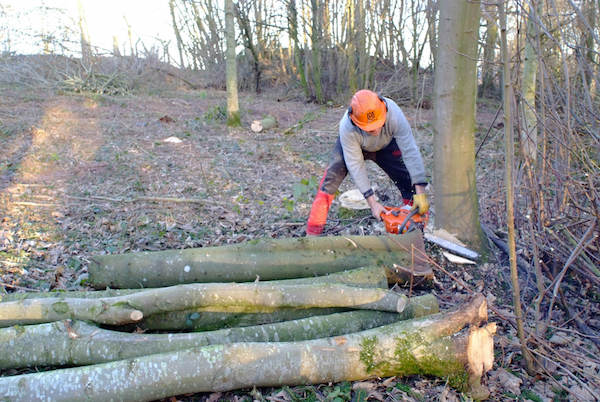
A Woodsman’s Work – Woodland thinning
Share
In watching a gardener thinning out a tray of lettuce seedlings, I am reminded that as a woodsman, I too am a gardener. My forest garden where wildlife thrives and time moves slowly may be a recent plantation of fast-growing trees (broadleaves or conifers), or some more ancient scrap of the wildwood that once covered much of Britain: most, if not all, of these woods are to be thinned from time to time.
Thinning trees is something of an art. There are some basic rules to follow, but always a good deal of judgement and experience is called for. But the woodsman has time – maybe a lifetime to gently remove the weak and poorly formed trees, giving the best trees the room and light to grow and develop fully. Sometimes the aim of thinning is more subtle, perhaps to remove invasive tree species or re-balance the desirable species as one was becoming too dominant; or even to manage the amount of light reaching the woodland floor through the tree canopy, for the benefit of rare plants or wildlife.
From a technical point of view the aim is to remove a proportion, or sometimes all, of the woodland’s increment – the amount of wood the trees are actually producing as they grow. Say woodland is growing at a rate of 4 cubic metres per year per hectare (1.6m3/acre), then the thinning will usually look to remove around 3 cubic metres of that growth. In that way the woodland’s growing stock is never depleted and the uncut proportion of newly grown wood becomes a ‘capital’ accumulation of timber and logs for a final felling at some time in the future.
I was first taught how to thin in some beautiful mixed woodlands rising from the banks of the river Dart in Devon; the old forester who taught me is sadly long gone now. Throughout my career I have always enjoyed the job of marking a woodland to be thinned. Such steady and careful work, assessing and selecting those trees which are to be removed in this thinning cycle. For conifers the cycle is usually about five years, while in most traditional broadleaves the cycle is more likely to be around 10 years. The thinning cycle is a compromise between the needs of the growing trees and the economics of harvesting the wood. If we have a 10 year cycle and remove 3m3/Ha of the average annual growth, then the woodsman is cutting 30m3/Ha during each thinning; and this is enough to justify bringing in the people and equipment needed to fell and extract the timber for its many uses – increasingly for firewood.
Thinning has always been a useful source of firewood as the trees being taken out can vary hugely in shape and size. The language of thinning is both archaic and modern. The ‘whip’ is a tall thin tree that flails about in strong winds, damaging its neighbours. The ‘wolf’ is rough, an over-sized giant taking up more space than its value will ever justify. The ‘suppressed’ and ‘sub-dominants’: weak and feeble trees, often barely alive, that struggle in the shade of their peers and will never thrive.
Thinning is helpful to the local economy too. It provides regular employment for those men and women who work in our woodlands and forests, and regular firewood for those of us who heat our homes with wood. This feeds money into the area, but importantly also back into the woodland. While walking through an oak and bluebell woodland with the old man who owned it some years ago, he told me that ‘we only care for the things that we value’. He said that he didn't trust his heirs had worked to ensure that his woodland was beautiful and productive, and, by doing so, he reasoned that this woodland would continue to thrive long after he was gone: the oaks were perfectly thinned!
People have had wood fires for well over a million years, and there is evidence of woodland management far back into pre-history. The art of thinning to remove usable timber and firewood, while maintaining the health and vitality of woodland may be very old indeed.
Vincent Thurkettle
Author ‘The Wood Fire Handbook’
 A copy of 'The Wood Fire Handbook is available to purchase at Amazon
A copy of 'The Wood Fire Handbook is available to purchase at Amazon
